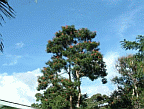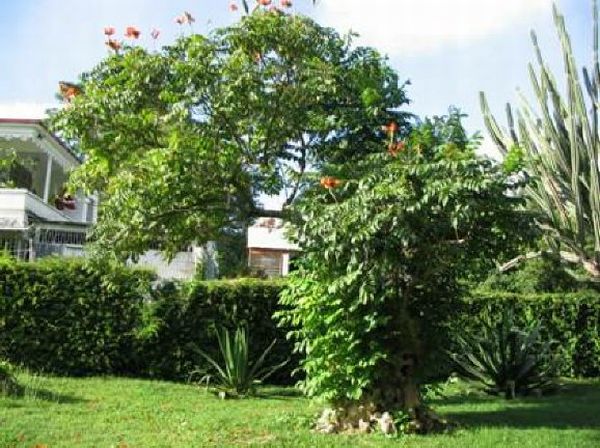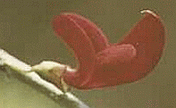




|

Arlington James
Plant Family: Bignoniaceae; family also includes the Sausage Tree (Kigelia africana), Calabash (Crescentia cujete) and the Pouis (Tabebuia spp.).
Description: Large, handsome tree, growing to a height of up to 24 m (80 ft), though most specimens are smaller; stem tends to become hollow, dropping large branches as tree ages, and tree easily shattered by high winds; compound leaves up to 40 cm (16 in.) with up to 9 pairs of dark green 5-10 cm leaflets (2-4 in.), the terminal leaflet unpaired; large red flowers, with boat-shaped, brownish-hairy calyx , about 10 cm across (4 in.); born in circular whorls with collection of crowded buds in center of circle; flowers born on tips of branches all over tree, making tree strikingly handsome and conspicuous at a distance; tree flowers throughout the year but in Dominica flowering is particularly abundant December to March, when flowering trees dot hillsides with splashes of red; unopened flowers contain water which can be released in a squirt, like a water pistol when the tip is cut and pressure applied; boat-shaped pod-like fruit up to 45 cm long (18 in.) with laterally winged seeds; wings transparent.
Natural Habitat: Likes moist locations below 900 m (3,000 ft) but will grow on drier sites and thrives at up to 1200 m (4,000 ft); biggest trees grow in moist, sheltered ravines; propagation by seed, root suckers and cuttings.
Origin and Distribution: Native of West Africa; introduced to many parts of the world, including the Caribbean.
Uses: Fast growing ornamental and shade tree; medicinal brews made from the bark, leaves and flowers for various illnesses; African hunters said to have boiled seeds to extract arrow poison; has weak, brittle wood, not much used for timber.
Indigenous Legends: In some parts of Africa, tree believed to have magical properties, and wands used by medicine men are made from its twigs; a string of the tree's red flowers at one's door marks the home-owner as a source of evil.
References:
Alan Eyre. The Botanic Gardens of Jamaica. Andre Deutsch, London 1966
G.W. Lennox and S.A. Seddon. Flowers of the Caribbean. Macmillan, London 1978
H.F. Macmillan. Tropical Planting and Gardening, Macmillan, London 1956
Dorothy P. Storer. Familiar Trees and Cultivated Plants of Jamaica. Macmillan, London 1964
US National Tropical Botanical Gardens, (ntbg.org). Kalaheo, Hawaii, 2004
C.D. Adams. Flowering Plants of Jamaica. University of the West Indies, Jamaica, Glasgow University Press 1972
|



